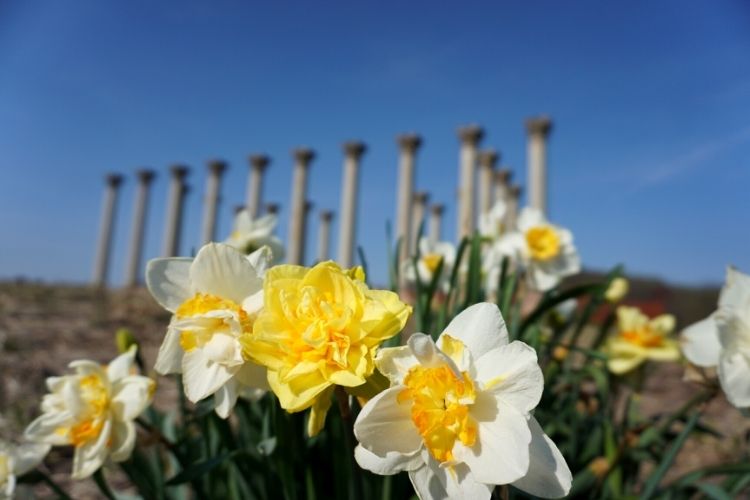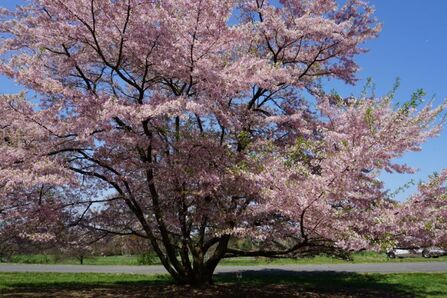|
What do a bonsai museum, cherry blossoms, and the National Herb Garden have in common? Visitors can find all three and much more at the fabulous U.S. National Arboretum in Washington, D.C. A true gem in the city, this 451 acre facility less than 15 minutes from the U.S. Capitol was established by Congress in 1927 as a facility to conduct research for the U.S. Department of Agriculture while also providing public education programs and serving as a public garden. While slightly off the main tourist path, the National Arboretum in DC still draws over half a million visitors per year, and if you visit, you will understand why. It’s an easy drive from downtown DC, and there’s plenty of free parking in several lots found throughout the Arboretum. So here’s my 6 reasons to add a visit to the U.S. National Arboretum to your Washington, DC bucket list. *Originally published in April, 2018; updated March, 2023. 1. The National Bonsai & Penjing Museum. Bonsai lovers will truly appreciate this outdoor museum with one of the largest collections of unique miniature trees in the country. Originally started when 53 Japanese bonsai were gifted to the United States along with 6 viewing stones as part of the Bicentennial in 1976. The museum contains a series of outdoor pavilions and gardens which encourage a peaceful stroll. New in 2024, look for the sacred Japanese temple bell as you enter the Japanese Pavilion. If you are a bonsai lover like my husband, you will want to spend hours studying each of the unique natural wonders, which reflect both the Chinese art of Penjing and the Japanese art of bonsai. Roam from room to room and be wowed, just know that the hours to enter the museum (10 a.m. to 4 p.m.) are slightly shorter than the overall grounds. If you are looking for a wonderful bonsai museum in DC, this is definitely the place to go! While the overall arboretum grounds are pet-friendly, dogs are not allowed in the National Bonsai & Penjing Museum. 2. The National Capitol Columns. As you take in the view across the meadow from the National Herb Garden, you might wonder about the random grouping of columns perched on a small hill in the Ellipse Meadow. Believe it or not, these columns once graced the East Portico of the U.S. Capitol building. It wasn’t until 1958 when a new addition was constructed that they were removed and put into storage. Then in the 1980’s, the columns found a permanent home at the Arboretum. The National Capitol Columns are popular with photographers, so expect there to be more crowds in that area. 3. Spring Blooms. Visit the Arboretum in springtime, and if your timing is good, you’ll likely find huge swaths of colorful seasonal flowers like tulips, along with beautiful flowering cherry trees. Take the self-guided tour, Beyond the Tidal Basin: Flowering Cherry Trees at the U.S. National Arboretum. Along the way, there will be about 3 dozen flowering cherry trees, including several Yoshino cherries that were grown from clippings of the original Tidal Basin cherry trees from Japan. Since we had just been on the Tidal Basin the week prior, we didn’t do the whole tour, but did enjoy seeing several of the trees in all their glory, including the spectacular tree below. The other spring blooms that draw a big crowd can be found in the Azalea Collections, with peak bloom typically at the end of April. Plan your trip with this Washington DC 3-Day Itinerary 4. The National Herb Garden. In the springtime, the National Herb Garden starts to come alive with herbs from around the world. Stroll the cottage-style garden where each of the themed gardens is marked, but I think my favorites were the Fragrance Garden and the Beverage Garden. I learned that the entrance to the garden is filled with seasonal flowers, and we were fortunate to visit when the tulips were at their peak! This area of the Arboretum is also home to the Historic and Species Rose Garden. The summer is typically when you can find the theme herb gardens in full bloom. 5. The Asian Collections. Tucked in a corner of the grounds that slope down to the Anacostia River are 13 acres that are part of the Asian Collections. It’s best to drive or bike to this section, where you’ll find a small parking lot. Explore China Valley, Asian Valley, the Korean Hillside and the Japanese Woodlands, where you will find something in bloom throughout the year. Don’t miss the beautiful red gazebo that separates the Asian Valley from the China Valley. One of my favorites here is the Camellia Collection, which typically bloom mid-fall into spring. Don’t miss a photo opportunity at the beautiful red gazebo that separates the Asian Valley from the China Valley. And if you keep following the trail from the gazebo, you will eventually wind down towards the river. You can also visit several other collections from this parking area, including the Dogwood Collection and the Gotelli Conifer Collection, so you can easily spend an hour in this area. Unfortunately the trails here are not handicapped-accessible. 6. It’s Free! Even though DC does have a large share of free museums and memorials, I wanted to point out that the Arboretum is also free. As an added bonus, parking is free, which is something that is not as common in DC. Pick up lunch from Union Market on your way over (another place with free parking but you can read more about that In the City: 3 Interesting Things to Do in DC) and picnic in the National Grove of State Trees picnic area. There’s several more areas to visit that I didn’t mention, including the Gotelli Conifer Collection, the Holly and Magnolia Collections, the Azalea Collections, the Dogwood Collection, and the Washington Youth Garden, which helps introduce local youth to the joy of gardening. So how long does it take to walk through the National Arboretum? You could easily spend at least half a day exploring if you want to see all the collections, or an hour or two to explore all the areas closest to the Visitor Center (Herb Garden, Capitol Columns, and the National Bonsai & Penjing Museum). With no admission fee and free parking, we have returned several times during different seasons, including twice with our bikes. In addition to the main lot near the visitor center, there are smaller lots scattered throughout the arboretum that bring you within walking distance to certain collections. Often the larger parking lot near the back of the arboretum is less crowded than the main parking area. If you are interested in exploring the National Arboretum by bike, there is a Capital Bikeshare location near the entrance at 24th and R Street NE. For more tips on things to do in Washington, DC, check out our Guide to Visiting Washington, DC. We recently added a 3-Day Washington Itinerary. And if you are looking for more beautiful botanic gardens to visit, we contributed to an article recently about 21 Best Botanical Gardens on the East Coast. . Pin for Later
0 Comments
Your comment will be posted after it is approved.
Leave a Reply. |









 RSS Feed
RSS Feed
